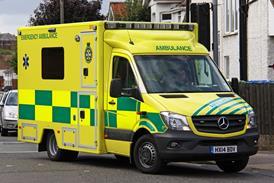As the financial climate has deteriorated, trusts have faced different challenges around investing in new equipment. Alison Moore speaks to managers organisations about the issues they and their colleagues face.
With services on five sites and a turnover of £1bn, Leeds Teaching Hospitals Trust is one of the largest in the UK. But its challenges are often those of every trust - such as deciding which new equipment to buy in the face of competing demands and a limited budget.
Head of supplies and procurement Chris Slater points out the problems many organisations face are not new: they have seen capital spending on medical, scientific and surgical equipment fall over the last few years with a focus on getting value for money out of their spending.
‘Everything is coming up to the end of its life when central funding for it has disappeared’
But even when money is available for capital spending, trusts have to consider the consequences, he says. If it has to be repaid, how will a trust afford this?
This has been an issue with the Department of Health’s £300m working capital equipment fund, which is administered through NHS Supply Chain and is designed to maximise collective buying power. The scheme allows trusts to buy equipment at reduced cost but even that may be an issue for some of them.
One consequence of the financial squeeze is that trusts are having to look at different ways of funding equipment.
“I don’t think the traditional capital route that we in Leeds have favoured in the past is necessarily the way forward. I think we will have to look at alternative ways of funding,” says Mr Slater. This could be leasing some equipment or using managed equipment services.
Residual value
“We know that we have to start exploring these alternative routes to see what value they bring in both the short and long term. We need to start to think outside the box to keep the level of investment needed.”
Any decisions have to weigh the pros and cons of each method - for example, leasing may only be worthwhile if there is some residual value at the end of a contract, he says.
As a non-foundation trust, Leeds will also have fewer options in terms of funding major purchases; its ability to borrow money is more limited than that of foundation trusts.
‘I don’t believe the NHS has been saving for a rainy day in any shape or form’
“Talking to fellow procurement colleagues and Supply Chain, there is an issue generally in that kit is getting older. Generally planning has always been difficult and has been directed by the level of investment available,” he says.
But as equipment has become more reliable, this has made the need for investment less pressing: it can simply be used for longer than originally envisaged and major expenditure can be delayed. The problem arises when that halcyon period ends, older kit becomes less reliable, and several pieces need replacing at the same time - putting a strain on any trust’s budget.
This can affect more than a single trust. Mr Slater points out that a large amount of oncology equipment came into use in the 2002-07 period when central funding was generous.
“That means everything is coming up to the end of its life when central funding for it has disappeared.”
In principle, trusts should have planned for this and started to allocate money for replacement equipment but in reality there is always something more immediately pressing such as replacing other equipment which has broken down, he says.
“I don’t believe the NHS has been saving for a rainy day in any shape or form,” he says. “The rule book has been rewritten.”
Juggling act
But recognition of the issue is crucial if the NHS is to start addressing it, head of medical physics and engineering David Brettle adds. “The problem I see is that we are all doing this at trust level. Who is doing this at the higher level?”
‘It is a juggling act at the moment: are we making the right decision, for this year, for next year, or over five years?’
Mr Slater adds: “We know what we have to replace because it is broken and we have ‘here and now’ issues if we don’t replace it.”
But planning for the longer term can very much be a “best guess” situation, he says. Commissioners and the centre need to play a part in indicating when money will be available and helping trusts avoid making rash decisions.
Another barrier is around understanding the shape of services in the future and therefore what equipment will be needed. As care is moved closer to home, the need for expensive bits of kit in hospital may change. But it is hard to call how quickly this shift will occur and what its impact will be.
“It is a juggling act at the moment: are we making the right decision, for this year, for next year, or over five years? Ultimately this goes back to doing the right thing for your patient and making certain we provide the best level of care for them,” Mr Slater says.
Trusts are having to ask how much of their portfolio they need to replace, he says. This can be influenced by a number of factors such as newer technology - which may make it obsolete - and the impact of 24/7 working and more intensive utilisation of equipment.
In theory this could mean less equipment is needed - more people can be scanned if imaging equipment is used for more hours a day, so fewer pieces of equipment are needed - but there may be other issues such as frequency of breakdown and when maintenance can be scheduled.
“Can we replace 100 per cent of an asset with 70, 60 or 50 per cent?” he asks. For trusts that provide services over a number of sites, there may be different issues - it may not be feasible to benefit from increased hours of use by reducing the total number of pieces of equipment if each site is required to improve patient access to services such as diagnostic imaging.
Opening the floodgates
Smaller equipment at Leeds is managed through a round the clock equipment library and can be sent out of wards as needed; this also allows for easy tracking of maintenance and cleaning.
‘We would like to think we involve or clinicians in most decisions. But the problem is overlaying the financial constraints that we have and getting them to understand the financial challenges’
The trust is fortunate in having an electrical and biomedical engineering department which can carry out a lot of basic maintenance itself. “We have a good relationship with our suppliers and in many cases our own people do first-line maintenance if a piece of equipment goes down.”
Even if this is just checking for simple faults, it can help to keep maintenance contract costs down. But as equipment gets older, breakdowns are not only more frequent but often more complex.
Clinician input is crucial to this, says Mr Slater.
“We would like to think we involve or clinicians in most decisions. But the problem is overlaying the financial constraints that we have and getting them to understand the financial challenges.
“When we do have funding and are going for a piece of equipment we do involve the clinicians at that point. But at the moment we are constrained in what we can offer. We want them to be involved but are a bit afraid of saying what is your wish list? The floodgates open.”
Medical equipment: A cure for old age

How minor investment could transform the ageing asset base of the NHS
- 1
 Currently
reading
Currently
reading
Ageing equipment: To replace or not to replace?
- 3






























No comments yet